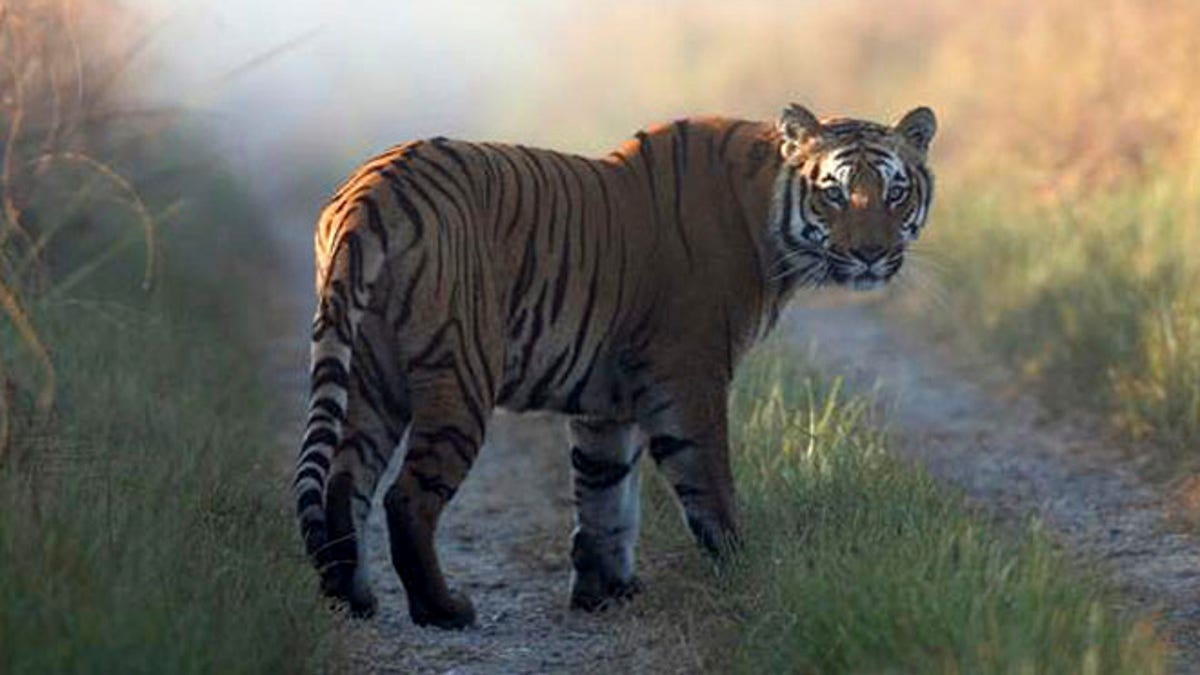
This undated file photo released by Corbett Tiger Reserve, shows a tiger at the reserve in the northern Indian state of Uttarakhand. Forest officials said another tiger who strayed from the park killed its 10th human victim in six weeks on Sunday, Feb. 9, 2014. (AP/Corbett Tiger Reserve/File)
A tiger prowling near villages in northern India killed its 10th person in six weeks, a day after eluding a trap set by hunters with a live calf as bait.
The female tiger is believed to have strayed from Jim Corbett National Park, India's oldest national park, which was established in 1936 to provide endangered Bengal tigers with safe territory.
The big cat's latest victim was a 50-year-old man who was collecting firewood Sunday night in the forest outside Kalgarh village in Uttarakhand state, according to Saket Badola, deputy director of the national park.
The animal ate parts of the man's leg and abdomen before being scared away by villagers waving shovels and metal rods.
According to the Times of India, experts suspect the attacker was a different tiger, a male who may have previously killed a woman in the area Jan. 14.
"There is thick forest in intervening area between Sunday's kill and the one that took place on Thursday," Bivash Pandav, a wildlife biologist with Wildlife Institute of India, told the paper. "This forest is populated by tigers. It's unlikely, although not impossible, that the tigress would have traversed through territories of other tigers to get to the Kalagarh spot."
"We are not rushing to any conclusion," Corbett field director Samir Sinha said. "Our priority would be to establish the identity of the tiger. We are placing camera traps in the area to get pictures. Besides, forest staff would try to gather more information by patrolling on foot and on elephants."
Hunters had almost nabbed the tiger a day earlier with a bovine calf.
"On Saturday night the tigress almost fell in trap and was close to the calf," Badola said. "But she did not attack the bait and left silently."
Reports that a killer tiger was on the loose began circulating Dec. 29, when a 65-year-old man was mauled in Sambhal district of Uttar Pradesh state, across the border from Uttarakhand. Since then, thousands of terrified villagers have been told to watch out for the animal and to avoid the forests.
The tiger has been on the prowl across an area spanning some 80 miles.
"The animal has started attacking humans because it is not getting its natural prey," said Rupek De, chief wildlife warden of Uttar Pradesh. "The tigress must be tired because it is not getting adequate rest."
He said the hunters hired to kill the animal were having trouble tracking it in dense forests. The team also was understaffed; only three of the six hunters hired for the job showed up for work, De said.
De said he asked wildlife officials in Uttarakhand for help, saying there seems to be lack of co-ordination.
On Sunday, angry villagers seized a national forestry office, demanding protection and compensation for the families of the dead.
"We can understand the predicament of the villagers," Badola said. "The villagers do not have toilets in their homes. They go out in the open or forest areas to answer nature's call. In this scenario it is difficult to give protection to each and every villager. We have advised them to move in groups."
India's wild tigers are considered endangered because of rampant poaching and shrinking habitat as India undergoes breakneck development to accommodate the staggering growth of its 1.2 billion people.
India today has more than half of the 3,200 tigers estimated to be left in the wild. Despite dozens of tiger reserves across the country, however, the numbers have sunk from an estimated 5,000-7,000 in the 1990s, when the big cats' habitat was twice as large.
The Associated Press contributed to this report.
